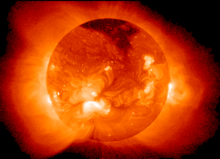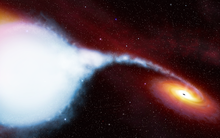X-ray source (astronomy)
In astronomy, an X-ray source is an object in space that emits X- rays. X-ray astronomy is concerned with researching X-ray sources .
The list of objects that can be observed in X-ray light is long. Starting with the sun, it ranges from stars to galaxy clusters, which show most of their baryonic mass only in the X-ray range.
Stellar X-ray sources
Soon after the X-ray observation possibilities were opened up to astronomy, it became apparent that the X-ray sky was littered with a large number of sources that can be associated with stars . Under these stars there are objects of all kinds that emit X-ray light under very different physical conditions.
The sun

Our sun is the closest stellar X-ray emitter. The surface of the sun that is visible to the naked eye (the photosphere ) is around 5800 Kelvin and therefore far too cool to emit significant amounts of (thermal) X-rays. This is only the case in the corona , which has an average temperature of two million degrees , the outermost atmospheric layer of the sun. The emission on the sun is by no means homogeneously distributed over the entire sphere, but is structured both temporally and spatially. It is mostly concentrated in small active areas and occurs both continuously and suddenly (see flare ). Responsible for this behavior is the solar magnetic field, which is significantly involved in the structuring and energy balance of the outer layers of the atmosphere. The knowledge gained from solar observations and the resulting models serve as a template for understanding the X-ray emissions of all “sun-like” stars.
Main sequence stars
Stars spend most of their lives on the main sequence . With regard to X-rays, a distinction is made between “late” and “early” stars according to the spectral type , with late roughly including the stars of the spectral types M to F and early the spectral types O and B. The main difference between these two groups is the mechanism by means of whose X-rays are generated. In late stars, X-rays are generated in a similar way to our sun. These stars have outer convection zones and can generate a (small-scale) magnetic field through the dynamo process , which is clearly shown in the structure of the solar corona. Large amounts of energy are stored in this magnetic field, which can be released in the outer layers of the atmosphere, contribute to their heating and ultimately lead to X-ray emissions. Early stars do not have such magnetic fields, but they are much brighter and generate much stronger winds than late stars. In these winds instabilities (shocks) develop, which heat the material to such an extent that X-ray emissions arise. Between the late and early stars there is still a class of main sequence stars (includes spectral type A, for example) which, according to the theory, have neither suitable magnetic fields nor strong enough winds that no X-rays are expected from these stars. During the ROSAT mission, however, it turned out that in around 15% of cases the position of a bright ( m v <6.5) A-star coincides with an X-ray source. It is not yet completely clear whether this finding indicates a mechanism for generating X-rays that is specific to these stars. The most widely accepted hypothesis, however, is that this radiation comes from late stars (hidden companions) in the vicinity of the A star, which are difficult to detect in other spectral ranges due to their comparable weakness.
X-ray binary stars
In X-ray binaries , there are systems consisting of a "normal" rating (for example, a main sequence star ) and a compact object ( white dwarf , neutron star or black hole ) are made. In these systems, material is accreted by the compact companion . This heats up strongly during this process and emits in the X-ray range.
Young stars

In star formation regions such as the Orion or Taurus region (see figure), the density of X-ray sources is particularly high. During their formation (before they begin their main sequence career), stars are particularly active X-ray emitters. The emission is due to both magnetic fields, winds and accretion . The exact point in time at which a protostar begins to emit X-rays is not known. Since very young objects are often still deeply embedded in a surrounding cloud, X-ray light is particularly suitable for discovering them and (at least partially) exploring their properties; the light from most of the other spectral ranges is absorbed much more strongly and can therefore only be analyzed with difficulty.
"Sources" within the solar system
Besides the sun itself, other objects are also observed in X-rays within our solar system . These include the moon , planets such as Venus , Mars and Saturn , and comets . However, these bodies do not generate the X-rays themselves, but are stimulated to emit by fluorescence and interaction with the solar wind .
Non-stellar and extragalactic sources
X-ray astronomy is instrumental in exploring the innermost regions of active galactic nuclei and the structure of the galaxy distribution.
Active galactic nuclei
These objects are the innermost areas of galaxies (order of magnitude 1 parsec), which appear point-like due to their comparatively large distance. In the center of an active nucleus there is a black hole that is surrounded by an accretion disk . In this region, high-energy events take place, which among other things lead to the release of X-rays. The spectra of active galactic nuclei can usually be described by a power law. A special application of X-ray light is the analysis of fluorescence lines. These arise from the reprocessing of X-ray photons in neutral (cool) material that is invisible per se in the X-ray range. They make it possible to learn something about the cool environment (for example the accretion disk) of the black hole.
Galaxy clusters
Galaxy clusters are among the largest structures in the universe. Long before the dawn of observation in the X-ray sector, it was known that these clusters cannot be stable with the mass that shines in the galaxies; but they seemed to be. Today it is known that most of the missing mass is in the form of dark matter (see bullet cluster ), but not all. Part of the missing mass, at least more than is bound in the stars, is in the form of a hot gas that collects in the center of the cluster. This can easily be seen with X-ray satellites, but not in other spectral ranges. This early discovery of X-ray astronomy roughly doubled the amount of known baryonic mass in the local universe in one fell swoop.
Gamma ray bursts
The term gamma ray burst ( English gamma ray burst , GRB) refers to a brief flare in gamma range. The time scale for such an outbreak is in the gamma ray range at a maximum of a few minutes. The gamma-ray burst is then followed by a longer "afterglow" (English. Afterglow ) in low-energy spectral range, ie for example in X-rays. GRBs are the most powerful bursts of electromagnetic radiation since the Big Bang. Research into them is only a few years old in astronomy. It is certain that these are extragalactic events, distributed arbitrarily in the sky, some with high redshifts . The underlying mechanism and the type of predecessor objects, however, are still controversial.
Videos
- Where does X-ray radiation come from in space? from the alpha-Centauri television series(approx. 15 minutes). First broadcast on Dec 5, 1999.

